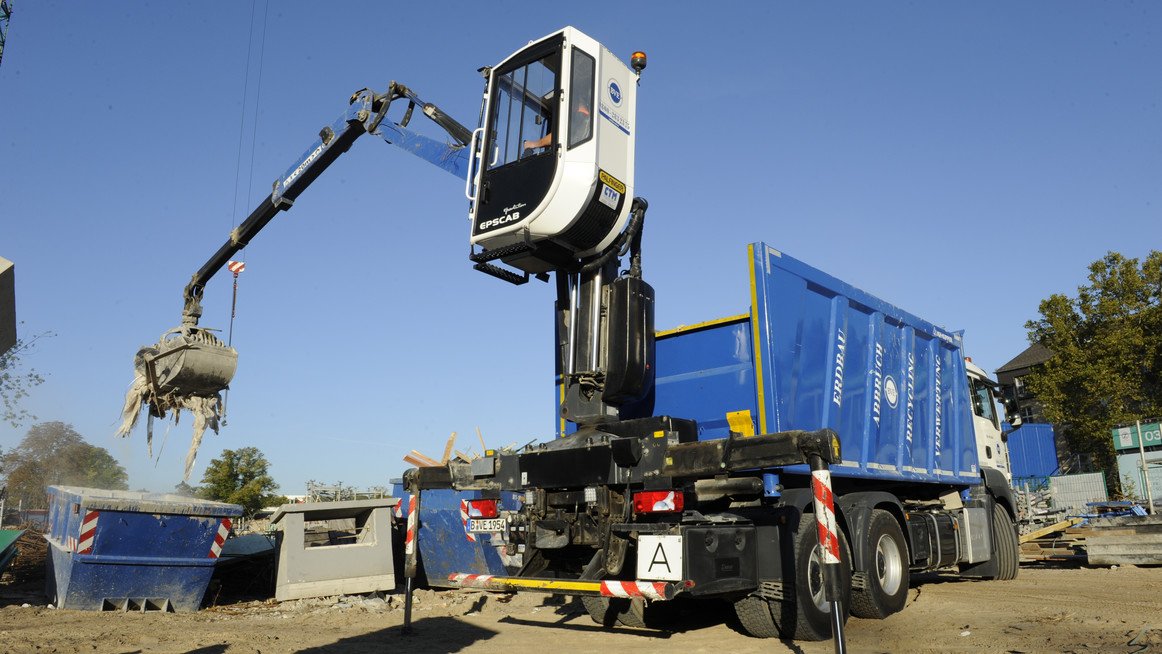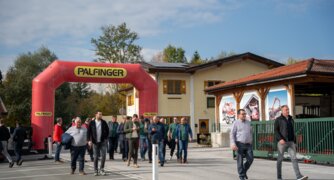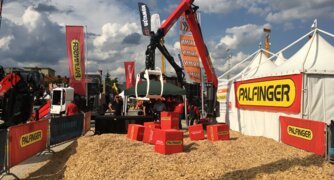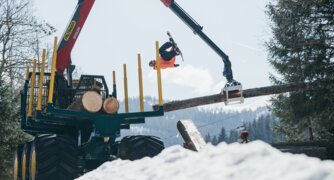WASTE DISPOSAL IN ABSOLUTE COMFORT
You can’t make an omelette without breaking eggs, as the saying goes. And when renovation or gutting work takes place or large new buildings reach into the sky, you have to break a lot of ‘eggs’. Builders use skips to dispose of all kinds of small construction waste, and these skips can contain all manner of materials – from bits of cables and old wood through to chunks of old concrete. And when these are full, you’ve got a problem.
In Berlin and the surrounding area, all you have to do is call Baustoffverwertung Eichberg (BVE) and Marco Binder – or one of his colleagues – will arrive with heavy machinery to empty the skips there and then and ensure work can continue smoothly on the construction site. His state-of-the-art MAN TGS 26.500 6x4 is equipped with a PALFINGER recycling crane at the rear so that the waste can be disposed of without the need for any outside help. To help him transport large amounts of rubble away from different construction sites throughout the capital, the 48-year-old is rarely out and about on his own and usually has his large container trailer in tow.
Marco starts his juggernaut at 5:00 a.m. and heads out into Berlin. Being the ‘early bird’ in the capital has its advantages, as he can make his way through the city without obstructions or traffic jams. Also, at this time, construction sites are not yet in operation, which means that the BVE driver can access the site without the stress of waiting or hurrying and position the 12-tonne-metre crane – complete with its dual extension – next to the waste containers. If Marco were to arrive any later, he could find himself in a queue behind delivery vehicles for the various trades, waiting to use the only – and narrow – access road through the canyon-like landscape between the tall buildings under construction.
Today, he’s in Charlottenburg, where a new Berliner Wasserbetriebe wastewater pumping station is being built, the Schlosspark-Klinik is being expanded and two housing developments are under construction. With so much action, things can get pretty tight with all the waiting. But not today, not for Marco. The trained bricklayer goes about his work very swiftly. To make it easier to manoeuvre his vehicle on site, the sturdy Berliner quickly decouples the trailer carrying the 40-cubic-metre container and makes his way with the three-axle vehicle towards the skips, which are brimming over with waste.
The 500-hp MAN moves into position, the crane stabilisers at the rear extend and Marco jumps into the crane cabin through the side door. With both hands, he moves the joystick with absolute precision. Few can master a crane like he can. Marco worked as a crane operator in construction for almost 20 years before signing on with BVE as the driver of a truck with a recycling crane.
Berlin-based BVE was founded back in 1996. Initially serving only Berlin and Brandenburg, the group has now long been active as a full service provider for site logistics across Germany. Its core areas of expertise include construction site management with logistics planning, construction site equipment, management of delivery operations, supply and disposal as well as site surveillance and access control. BVE also performs demolition and gutting work as well as bulk material transportation and operates a rubble recycling plant, a rubble landfill and a gravel plant.
In Berlin-Brandenburg, Hamburg and Munich, BVE also offers its own container service for the waste disposal sector. To help with this, the company operates seven trucks with skiploaders and hookloaders or self-loading cranes and has around 600 of its own waste containers with storage capacities ranging from 7 to 40 cubic metres.
‘I have equipped three of the self-loading crane vehicles with an M-series PALFINGER device. I couldn’t be happier – not least because the crane cabins are also really sturdy,’ says BVE managing director Herrmann Müller. He discovered his appreciation for the enclosed cabin in Scandinavia because it enables people to work whatever the weather and make better use of their working hours.
Marco also swears by the comfortable EPSCAB crane cabin from PALFINGER and sees it as one of the reasons he continues to work for BVE to this day. After all, he has been working for the company for 13 years and is more than happy with his work. He says that the conditions are great. The salary, working hours and tools are all good. And by ‘tools’, he is referring to his 26-tonne truck with PALFINGER EPSILON M12L plus crane cabin. According to Marco, it really is perfect for use all year round: pleasantly air-conditioned in summer and easy to heat with the auxiliary heater in winter. This means that Marco can work in short sleeves all year round and is still almost never ill. He also says that the stable, secure and enclosed cabin keeps fine construction dust at bay – something whose importance cannot be underestimated when you do this kind of work day in, day out. He says that he knows colleagues who suffer from silicosis, and you can never really know exactly which harmful substances are still contained in the dust.
Like the professional he is, and with the experience of someone who has done this all his working life, Marco uses the clamshell grabber to reach into the dump body on the floor to scrape out almost every last bit of rubble and transfer it into the truck container. When there is nothing left to collect, he heads up the narrow access road back to the parked trailer. To ensure optimal load distribution, the crane expert shovels several grabber-loads of rubble into the trailer’s voluminous container, couples the vehicles together and drives to the next construction site to collect more rubble.
This is around four kilometres away, but still in Charlottenburg. The building shell has already been completed, and now the different trades are hard at work in the interior of the building. This means that the skips are full of not only building rubble, but also leftover reinforced steel, wooden slats, power cables, rubber, polystyrene, plastic, paper and fabric remnants. Marco fishes the material out and tries to separate it as best he can. It is really the job of the tradespeople to ensure that waste is properly separated and disposed of in different containers. But there is often not enough space for so many containers – not to mention the fact that construction workers can often be careless and lazy when it comes to waste separation.
So that Marco can see exactly what each skip contains, he raises the crane cabin up approximately four metres in the air. The windscreen protects him against falling objects or objects striking the cabin. The windscreen is made from eight-millimetre-thick Lexan safety glass, so is more than able to withstand the odd knock.
Once everything has been loaded, the BVE employee places the rear crane of the PALFINGER M-series down onto the rubble in the container, brings the crane cabin into the drive position and reverses almost 100 metres along the narrow site access road. Fully laden, the container juggernaut leaves the centre of Berlin and heads to Grünau, almost 30 kilometres away to the south of the capital. His destination: the BVE recycling centre. Here, Marco raises the rear crane high enough so that the truck container can tip the rubble out to the side. Concrete rubble, quarry stone, sand and gravel hail down onto the edge of a mighty mountain of rubble. Later, wheel loaders push the material together, which is eventually taken to a crushing plant so that it can be used as filling material in road construction. Anything not suitable for this ends up in the BVE landfill in Eichberg.
The plastic, cables, wood, waste cardboard and paper in the trailer go to the sorting plant. The driver carefully manoeuvres the trailer backwards through the gate of the plant, where material awaiting recycling lies in great heaps, sometimes as high as the ceiling. A hydraulic mechanism tips the enormous container, which empties via the opened rear portal.
For the recycling crane, container trailer and driver, it’s job done for the day. The vehicle and crane undergo a spot of maintenance – after all, the truck complete with crane mounting is to be in service at BVE for at least three years. The vehicle covers a distance of around 60,000 kilometres every year, so when there are around 180,000 kilometres on the clock, Müller starts thinking about replacements. Maintenance and repairs are performed exclusively by external service companies, with comprehensive maintenance and repair contracts taken out with PALFINGER and MAN. Crane servicing is performed by CTM Fahrzeugbau GmbH, which, as an authorised PALFINGER sales and service partner, was also responsible for ordering and mounting the rear crane. Outstanding service partners for crane vehicles are absolutely vital in the rough-and-tumble world of the disposal industry – after all, you can’t make an omelette without breaking eggs.




